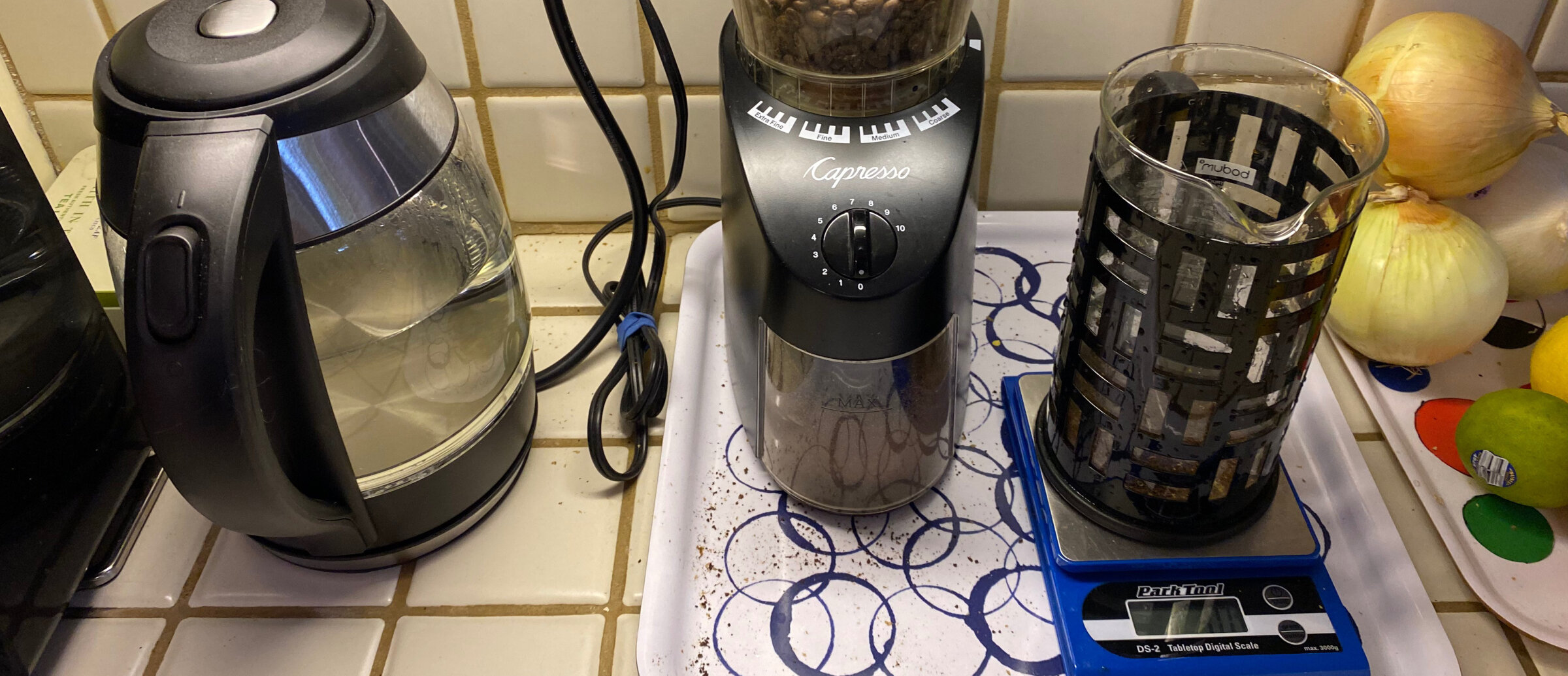Coffee Debate
Back to my coffee; I brew a French press pot every morning; without which I have neither long-term, nor short-term memory. There’s an insignificant point of dispute in my household regarding the method of measuring the amount of coffee. Both my housemate and I remember (with the long term memory and knowledge in our heads) that our optimal coffee robustness requires 30grams of coffee; I have repurposed this gram scale from my bicycle workshop to achieve this amount. It is the method of weighing this value is the point of dispute. She claims it is more efficient to weigh the 30g in the same vessel the coffee is ground into. In an effort to “conform” I wrote the tare weight of the receptacle on the bottom, in order to precisely weigh the optimal 30g. This is an example of me putting the memory in the world, accessing knowledge in the world. This is obviously one too many numbers for me to have to retain and recall while bleary eyed in the morning, which is only part of my logic for weighing the coffee grinds the way I do. I merely place the coffee pot on the scale, press the tare button, and dump the coffee into the pot until it reads 30g. I have no idea how much my French press pot weighs, I don’t care. The scale is providing me the tare, this is my knowledge in the world. Sometimes I am not careful and accidentally pour too much in, to the point that up to 36g of coffee is brewed. (This is not a problem, it still drinks, albeit a little harsher). What does the housemate do when she has accidentally ground too much, and the receptacle on the scale reads 120 grams instead of the 116g as it is supposed to? How much does she pour into the pot?
But this is the heart of the dispute in my mind though, the coffee grinder itself lacks sufficient constraints. There is no physical constraint preventing over or under grinding, or even any indexing on the graduations of the grind dial. Did I rotate the dial exactly to “3”? Was it over or under? The mapping is demonstrating the conceptual modelthat “1” on the dial indicates 10 grams. But without any of the tactile feel at each graduation, there is little precise feedback. When I pour in the grinds and it only reads 28g, this must be rectified! So I put the grounds receptacle back in, and give the dial a nudge, again, there’s no graduations for single grams, so I usually have to nudge it a few more times. If I nudge too far, it’s sure to over grind too much. The dial has graduations on it “0 – 10” and when turned, it activates the grinder and slowly winds itself back to “0” much like an analog kitchen timer; from our experience, dialing “3” yields 30g of coffee. This is a logical constraint, but by the lack of the physical indexing in the dial—tactile stops at each graduation—I would qualify it as loosely logical. (It is also a logical constraint as to where the ground coffee receptacle resides on the grinder, as it is the only place it will fit).
We also have several other forms of coffee brewing that we enjoy in our house. The fantastic Bialetti stovetop espresso. (The only cultural constraint using this device is an air of European snobbery is suddenly required.) Beyond that, its role in this entry is its demand for finer ground coffee. Which our grinder affords, the ability to produce a wide spectrum of varying coarseness. At the bottom ring of the bean hopper is the grind adjustment ring, which does provide adequate feedback in knowing what grind setting it is in, by the indexing tactile feel. This adjustment is another problem as well. On the occasions we make stovetop espresso, our newly adopted laissez-faire attitude prevents us from remembering to return the grinder to the optimal setting for French press. At which point the next morning, we grind 30+ grams of powder, unusable for the press.
It would help if the grinder had a more prominent indicator, or signifier, of what grind setting it was set to; helping further would be some type of reminder constraint, an interlock force function that verified volume of grind (perhaps even with a built in scale) and coarseness of grind before starting.

